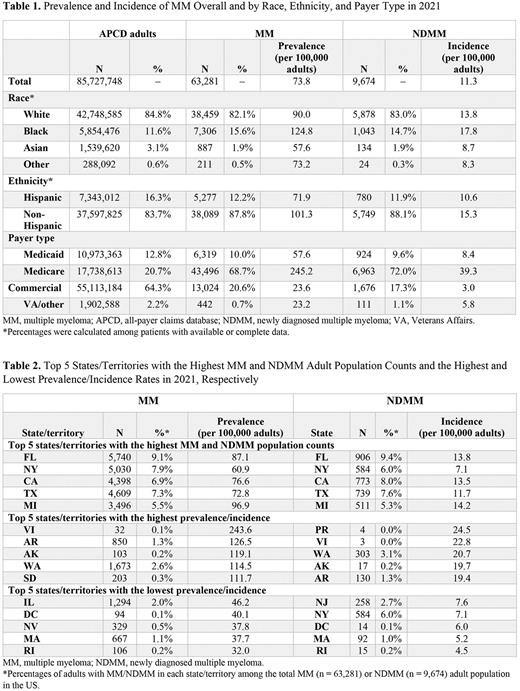Abstract
Introduction: Multiple myeloma (MM) is a rare and heterogeneous cancer with steadily improving patient survival in recent years due to advancement in therapies. Updates to the prevalence and incidence of MM using the latest nationally representative data are needed to support population health management, resource planning, and health economic assessments. Furthermore, disparities in disease burden, access to care, treatment patterns, and outcomes could exist across patient subpopulations with MM, prompting a need for comprehensive data to understand the population. Currently, there is a gap in such data due to the highly fragmented health care system in the US in which real-world evidence is often siloed and represents only a portion of the population. This study aims to provide a national view of MM by estimating the prevalence and incidence in US adults overall and by state/territory, payer type, race, and ethnicity in 2021.
Methods: This is a retrospective study using the All-Payer Real-World Multiple Myeloma Research-Ready Data built using the US national all-payer claims database (APCD), which covers ~87% of the nationally insured population from 1/1/2014 to 1/31/2022. Data included adults with ≥2 claims with MM diagnosis (ICD-9-CM: 203.0x and ICD-10-CM: C90.0x) who had continuous capture with medical and pharmacy benefits for ≥12 months prior to and 30 days after the first MM diagnosis date. To be included in this study, patients also had to have ≥1 claim in 2021. The latest claim date in 2021 was defined as the index date. A subcohort of patients with newly diagnosed MM (NDMM; incident MM cases) were additionally required to have their first MM diagnosis date (the index date for the NDMM cohort) in 2021. Prevalence and incidence of MM were estimated using the number of patients in MM and NDMM cohorts, divided by the total APCD adult population with similar continuous capture eligibility. Prevalence and incidence were calculated for the overall population and stratified by state/territory, payer type, race, and ethnicity. Patient characteristics were captured at the index date and during the baseline period. The proportion of patients with NDMM who initiated their first treatment in 2021 and the time from diagnosis to their first treatment were captured.
Results: A total of 63,281 MM and 9,674 NDMM patients met the study criteria. Mean age was 71.1 and 70.0 years, 51.4% and 52.9% were male, and 68.7% and 72.0% were covered by Medicare, respectively. Overall, about two-thirds of the patients had available race (74%), ethnicity (69%), and income data (76%), while 46% had education status. Among those with data, 15.6% of MM and 14.7% of NDMM cohorts were Black, 12.2% and 11.9% were Hispanic, 65.1% and 64.5% had an annual income ≤$50,000, and 67.5% and 67.2% had high school as their highest level of education. The overall prevalence of MM was 73.8 per 100,000 adults in 2021, with the prevalence being the highest among those who were Black (124.8), non-Hispanic (101.3), covered by Medicare (245.2), and residing in the US Virgin Islands (243.6) and Arkansas (126.5). The overall incidence of NDMM was 11.3 per 100,000 adults in 2021, and the incidence was highest among those who were Black (17.8), non-Hispanic (15.3), covered by Medicare (39.3), and those residing in Puerto Rico (24.5), the US Virgin Islands (22.8), and Washington (20.7; Tables 1 and 2). The mean Quan-Charlson comorbidity index (excluding MM diagnosis) was 2.8 for the MM cohort and 2.4 for the NDMM cohort. Commonly observed comorbidities for both cohorts included anemia (44.8% and 47.4%), diabetes with chronic complications (23.9% and 22.4%), peripheral neuropathy (24.8% and 15.2%), renal impairment (22.7% and 20.1%), and infections (21.9% and 14.4%). There were 3,377 (35%) patients with NDMM who initiated their first treatment in 2021, with a mean and median time to treatment of 50.8 (standard deviation = 67.5) and 27 days.
Conclusions: While the prevalence and incidence of MM in 2021 estimated in this study were consistent with projected estimates from the literature, variations in rates of MM were observed across race, ethnicity, payer type, and state/territory, indicating potential disparities in the burden of MM. Such a comprehensive view of rates of MM could serve as a foundation for future health policy decisions, quality improvement, resource deployment, and initiatives to address health disparities across subpopulations.
Disclosures
Lin:Janssen Scientific Affairs, LLC: Current Employment. Kim:Janssen: Current Employment. Ledford:Janssen: Current Employment. Brunisholz:Janssen Scientific Affairs, LLC: Current Employment. Medhekar:Janssen Pharmaceuticals: Current Employment, Current equity holder in publicly-traded company. Abramovitz:Janssen: Consultancy. Maughn:Janssen Scientific Affairs, LLC: Consultancy. Wu:Janssen Scientific Affairs, LLC: Current Employment.
Author notes
Asterisk with author names denotes non-ASH members.


This feature is available to Subscribers Only
Sign In or Create an Account Close Modal